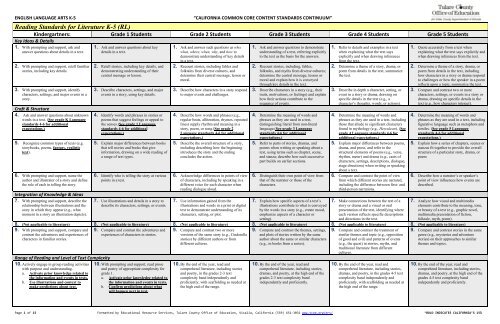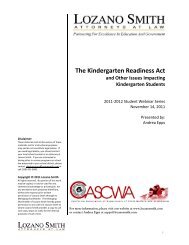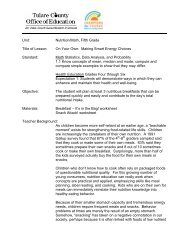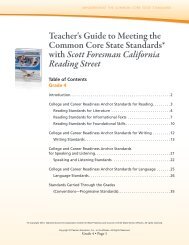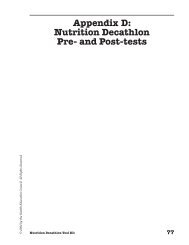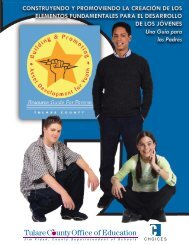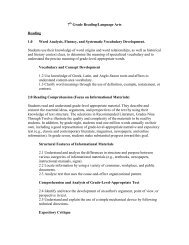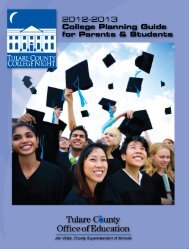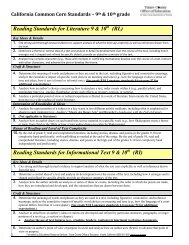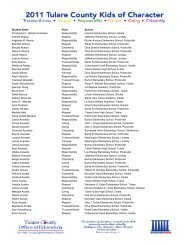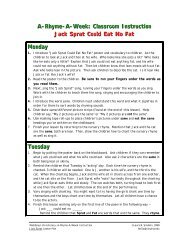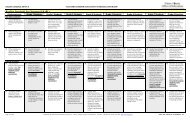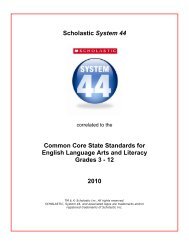CCCS K-5 ELA Continuum - Tulare County Office of Education
CCCS K-5 ELA Continuum - Tulare County Office of Education
CCCS K-5 ELA Continuum - Tulare County Office of Education
- No tags were found...
You also want an ePaper? Increase the reach of your titles
YUMPU automatically turns print PDFs into web optimized ePapers that Google loves.
ENGLISH LANGUAGE ARTS K‐5 “CALIFORNIA COMMON CORE CONTENT STANDARDS CONTINUUM”Reading Standards for Literature K-5 (RL)Kindergartners: Grade 1 Students Grade 2 Students Grade 3 Students Grade 4 Students Grade 5 StudentsKey Ideas & Details1. With prompting and support, ask andanswer questions about details in a text.2. With prompting and support, retell familiarstories, including key details.3. With prompting and support, identifycharacters, settings, and major events in astory.Craft & Structure4. Ask and answer questions about unknownwords in a text. (See grade K Languagestandards 4-6 for additionalexpectations.)5. Recognize common types <strong>of</strong> texts (e.g.storybooks, poems, fantasy, realistictext).6. With prompting and support, name theauthor and illustrator <strong>of</strong> a story and definethe role <strong>of</strong> each in telling the story.Integration <strong>of</strong> Knowledge & Ideas7. With prompting and support, describe therelationship between illustrations and thestory in which they appear (e.g., whatmoment in a story an illustration depicts).1. Ask and answer questions about keydetails in a text.2. Retell stories, including key details, anddemonstrating understanding <strong>of</strong> theircentral message or lesson.3. Describe characters, settings, and majorevents in a story, using key details.4. Identify words and phrases in stories orpoems that suggest feelings or appeal tothe senses.(See grade 1 Languagestandards 4-6 for additionalexpectations.)5. Explain major differences between booksthat tell stories and books that giveinformation, drawing on a wide reading <strong>of</strong>a range <strong>of</strong> text types.6. Identify who is telling the story at variouspoints in a text.7. Use illustrations and details in a story todescribe its characters, settings, or events.1. Ask and answer such questions as who,what, where, when, why, and how todemonstrate understanding <strong>of</strong> key detailsin a text.2. Recount stories, including fables andfolktales from diverse cultures, anddetermine their central message, lesson ormoral.3. Describe how characters in a story respondto major events and challenges.4. Describe how words and phrases (e.g.,regular beats, alliteration, rhymes, repeatedlines) supply rhythm and meaning in astory, poem, or song.(See grade 2Language standards 4-6 for additionalexpectations.)5. Describe the overall structure <strong>of</strong> a story,including describing how the beginningintroduces the story and the endingconcludes the action.6. Acknowledge differences in points <strong>of</strong> view<strong>of</strong> characters, including by speaking in adifferent voice for each character whenreading dialogue aloud.7. Use information gained from theillustrations and words in a print or digitaltext to demonstrate understanding <strong>of</strong> itscharacters, setting, or plot.1. Ask and answer questions to demonstrateunderstanding <strong>of</strong> a text, referring explicitlyto the text as the basis for the answers.2. Recount stories, including, fables,folktales, and myths from diverse cultures;determine the central message, lesson ormoral and explain how it is conveyedthrough key details in the text.3. Describe characters in a story (e.g., theirtraits, motivations, or feelings) and explainhow their actions contribute to thesequence <strong>of</strong> events.4. Determine the meaning <strong>of</strong> words andphrases as they are used in a text,distinguishing literal from non-literallanguage.(See grade 3 Languagestandards 4-6 for additionalexpectations.)5. Refer to parts <strong>of</strong> stories, dramas, andpoems when writing or speaking about atext, using terms such as chapter, scene,and stanza; describe how each successivepart builds on earlier sections.6. Distinguish their own point <strong>of</strong> view fromthat <strong>of</strong> the narrator or those <strong>of</strong> thecharacters.7. Explain how specific aspects <strong>of</strong> a text’sillustrations contribute to what is conveyedby the words in a story (e.g., create mood,emphasize aspects <strong>of</strong> a character orsetting).1. Refer to details and examples in a textwhen explaining what the text saysexplicitly and when drawing inferencesfrom the text.2. Determine a theme <strong>of</strong> a story, drama, orpoem from details in the text; summarizethe text.3. Describe in depth a character, setting, orevent in a story or drama, drawing onspecific details in the text (e.g., acharacter’s thoughts, words, or actions).4. Determine the meaning <strong>of</strong> words andphrases as they are used in a text, includingthose that allude to significant charactersfound in mythology (e.g., Herculean). (Seegrade 4 Language standards 4-6 foradditional expectations.)5. Explain major differences between poems,drama, and prose, and refer to thestructural elements <strong>of</strong> poems (e.g., verse,rhythm, meter) and drama (e.g., casts <strong>of</strong>characters, settings, descriptions, dialogue,stage directions) when writing or speakingabout a text.6. Compare and contrast the point <strong>of</strong> viewfrom which different stories are narrated,including the difference between first- andthird-person narrations.7. Make connections between the text <strong>of</strong> astory or drama and a visual or oralpresentation <strong>of</strong> the text, identifying whereeach version reflects specific descriptionsand directions in the text.1. Quote accurately from a text whenexplaining what the text says explicitly andwhen drawing inferences from the text.2. Determine a theme <strong>of</strong> a story, drama, orpoem from details in the text, includinghow characters in a story or drama respondto challenges or how the speaker in a poemreflects upon a topic; summarize the text.3. Compare and contrast two or morecharacters, settings, or events in a story ordrama, drawing on specific details in thetext (e.g., how characters interact).4. Determine the meaning <strong>of</strong> words andphrases as they are used in a text, includingfigurative language such as metaphors andsimiles. (See grade 5 Languagestandards 4-6 for additionalexpectations.)5. Explain how a series <strong>of</strong> chapters, scenes orstanzas fit together to provide the overallstructure <strong>of</strong> a particular story, drama, orpoem6. Describe how a narrator’s or speaker’spoint <strong>of</strong> view influences how events aredescribed.7. Analyze how visual and multimediaelements contribute to the meaning, tone,or beauty <strong>of</strong> a text (e.g., graphic novel,multimedia presentation <strong>of</strong> fiction,folktale, myth, poem).8. (Not applicable to literature) 8. (Not applicable to literature) 8. (Not applicable to literature) 8. (Not applicable to literature) 8. (Not applicable to literature) 8. (Not applicable to literature)9. With prompting and support, compare andcontrast the adventures and experiences <strong>of</strong>characters in familiar stories.Range <strong>of</strong> Reading and Level <strong>of</strong> Text Complexity10. Actively engage in group reading activitieswith purpose and understanding.a. Activate prior knowledge related tothe information and events in texts.b. Use illustrations and context tomake predictions about text.9. Compare and contrast the adventures andexperiences <strong>of</strong> characters in stories.10. With prompting and support, read proseand poetry <strong>of</strong> appropriate complexity forgrade 1.a. Activate prior knowledge related tothe information and events in texts.b. Confirm predictions about whatwill happen next in text.9. Compare and contrast two or moreversions <strong>of</strong> the same story (e.g., Cinderellastories) by different authors or fromdifferent cultures.10. By the end <strong>of</strong> the year, read andcomprehend literature, including storiesand poetry, in the grades 2-3 textcomplexity band independently andpr<strong>of</strong>iciently, with scaffolding as needed atthe high end <strong>of</strong> the range.9. Compare and contrast the themes, settings,and plots <strong>of</strong> stories written by the sameauthor about the same or similar characters(e.g., in books from a series).10. By the end <strong>of</strong> the year, read andcomprehend literature, including stories,dramas, and poetry, at the high end <strong>of</strong> thegrades 2-3 text complexity bandindependently and pr<strong>of</strong>iciently.9. Compare and contrast the treatment <strong>of</strong>similar themes and topic (e.g., opposition<strong>of</strong> good and evil) and patterns <strong>of</strong> events(e.g., the quest) in stories, myths, andtraditional literature from differentcultures.10. By the end <strong>of</strong> the year, read andcomprehend literature, including stories,dramas, and poetry, in the grades 4-5 textcomplexity band independently andpr<strong>of</strong>iciently, with scaffolding as needed atthe high end <strong>of</strong> the range.9. Compare and contrast stories in the samegenre (e.g., mysteries and adventurestories) on their approaches to similarthemes and topics.10. By the end <strong>of</strong> the year, read andcomprehend literature, including stories,dramas, and poetry, at the high end <strong>of</strong> thegrades 4-5 text complexity bandindependently and pr<strong>of</strong>iciently.Page 1 <strong>of</strong> 15 Formatted by <strong>Education</strong>al Resource Services, <strong>Tulare</strong> <strong>County</strong> <strong>Office</strong> <strong>of</strong> <strong>Education</strong>, Visalia, California (559) 651‐3031 www.tcoe.org/ers/ *BOLD INDICATES CALIFORNIA’S 15%
ENGLISH LANGUAGE ARTS K‐5 “CALIFORNIA COMMON CORE CONTENT STANDARDS CONTINUUM”Reading Standards for Informational Text K-5 (RI)Kindergartners: Grade 1 Students Grade 2 Students Grade 3 Students Grade 4 Students Grade 5 StudentsKey Ideas & Details1. With prompting and support, ask andanswer questions about key details in atext.2. With prompting and support, identify themain topic and retell key details <strong>of</strong> a text.3. With prompting and support, describe theconnection between two individuals,events, ideas, or pieces <strong>of</strong> information in atext.Craft & Structure4. With prompting and support, ask andanswer questions about unknown words ina text. (See grade K Language standards4-6 for additional expectations.)5. Identify the front cover, back cover, andtitle page <strong>of</strong> a book.6. Name the author and illustrator <strong>of</strong> a textand define the role <strong>of</strong> each in presentingthe ideas or information in a text.Integration <strong>of</strong> Knowledge & Ideas7. With prompting and support, describe therelationship between illustrations and thetext in which they appear (e.g., whatperson, place, thing, or idea in the text anillustration depicts).8. With prompting and support, identify thereasons an author gives to support points ina text.9. With prompting and support, identify basicsimilarities in and differences between twotexts on the same topic (e.g., inillustrations, descriptions, or procedures).1. Ask and answer questions about keydetails in a text.2. Identify the main topic, and retell keydetails in a text.3. Describe the connection between twoindividuals, events, ideas, or pieces <strong>of</strong>information in a text.4. Ask and answer questions to helpdetermine or clarify the meaning <strong>of</strong> wordsand phrases in a text. (See grade 1Language standards 4-6 for additionalexpectations.)5. Know and use various text structures(e.g., sequence) and text features (e.g.,headings, tables <strong>of</strong> contents, glossaries,electronic menus, icons) to locate key factsor information in a text.6. Distinguish between information providedby pictures or other illustrations andinformation provided by the words in atext.7. Use the illustrations and details in a text todescribe its key ideas.8. Identify the reasons an author gives tosupport points in a text.9. Identify basic similarities in anddifferences between two texts on the sametopic (e.g., in illustrations, descriptions, orprocedures).1. Ask and answer such questions as who,what, where, when, why, and how todemonstrate understanding <strong>of</strong> key detailsin a text.2. Identify the main topic <strong>of</strong> a multiparagraphtext as well as the focus <strong>of</strong> specificparagraphs within the text.3. Describe the connection between a series<strong>of</strong> historical events, scientific ideas orconcepts, or steps in technical proceduresin a text.4. Determine the meanings <strong>of</strong> words andphrases in a text relevant to a grade 2 topicor subject area.(See grade 2 Languagestandards 4-6 for additionalexpectations.)5. Know and use various text features (e.g.,captions, bold print, subheadings,glossaries, indexes, electronic menus,icons) to locate key facts or information ina text efficiently.6. Identify the main purpose <strong>of</strong> a text,including what the author wants to answer,explain, or describe.7. Explain how specific images (e.g., adiagram showing how a machine works)contribute to and clarify a text.8. Describe how reasons support specificpoints the author makes in a text.9. Compare and contrast the most importantpoints presented by two texts on the sametopic.1. Ask and answer questions to demonstrateunderstanding <strong>of</strong> a text, referring explicitlyto the text as the basis for the answers.2. Determine the main idea <strong>of</strong> a text; recountthe key details and explain how theysupport the main idea.3. Describe the relationship between a series<strong>of</strong> historical events, scientific ideas orconcepts, or steps in technical proceduresin a text, using language that pertains totime, sequence, and cause/effect.4. Determine the meaning <strong>of</strong> generalacademic and domain-specific words andphrases in a text relevant to a grade 3 topicor subject area.(See grade 3 Languagestandards 4-6 for additionalexpectations.)5. Use text features and search tools (e.g.,key words, sidebars, hyperlinks) to locateinformation relevant to a given topicefficiently.6. Distinguish their own point <strong>of</strong> view fromthat <strong>of</strong> the author <strong>of</strong> a text7. Use information gained from illustrations(e.g., maps, photographs) and the words ina text to demonstrate understanding <strong>of</strong> thetext (e.g., where, when, why, and how keyevents occur).8. Describe the logical connection betweenparticular sentences and paragraphs in atext (e.g., comparison, cause/effect,first/second/third in a sequence).9. Compare and contrast the most importantpoints and key details presented in twotexts on the same topic.1. Refer to details and examples in a textwhen explaining what the text saysexplicitly and when drawing inferencesfrom the text.2. Determine the main idea <strong>of</strong> a text andexplain how it is supported by key details;summarize the text.3. Explain events, procedures, ideas, orconcepts in a historical, scientific, ortechnical text, including what happenedand why, based on specific information inthe text.4. Determine the meaning <strong>of</strong> generalacademic and domain-specific words orphrases in a text relevant to a grade 4 topicor subject area.(See grade 4 Languagestandards 4-6 for additionalexpectations.)5. Describe the overall structure (e.g.,chronology, comparison, cause/effect,problem/solution) <strong>of</strong> events, ideas,concepts, or information in a text or part <strong>of</strong>a text.6. Compare and contrast a firsthand andsecondhand account <strong>of</strong> the same event ortopic; describe the differences in focus andthe information provided.7. Interpret information presented visually,orally, or quantitatively (e.g., in charts,graphs, diagrams, time lines, animations,or interactive elements on Web pages) andexplain how the information contributes toan understanding <strong>of</strong> the text in which itappears.8. Explain how an author uses reasons andevidence to support particular points in atext.9. Integrate information from two texts on thesame topic in order to write or speak aboutthe subject knowledgeably.1. Quote accurately from a text whenexplaining what the text says explicitly andwhen drawing inferences from the text.2. Determine two or more main ideas andhow they are supported by key details;summarize the text.3. Explain the relationships or interactionsbetween two or more individuals, events,ideas, or concepts in a historical, scientific,or technical text based on specificinformation in the text.4. Determine the meaning <strong>of</strong> generalacademic and domain-specific words andphrases in a text relevant to a grade 5 topicor subject area. (See grade 5 Languagestandards 4-6 for additionalexpectations.)5. Compare and contrast the overall structure(e.g., chronology, comparison,cause/effect, problem/solution) <strong>of</strong> events,ideas, concepts, or information in two ormore texts.6. Analyze multiple accounts <strong>of</strong> the sameevent or topic, noting importantsimilarities and differences in the point <strong>of</strong>view they represent.7. Draw on information from multiple printor digital sources, demonstrating theability to locate an answer to a questionquickly or to solve a problem efficiently.8. Explain how an author uses reasons andevidence to support particular points in atext, identifying which reasons andevidence support which point(s).9. Integrate information from several texts onthe same topic in order to write or speakabout the subject knowledgeably.Range <strong>of</strong> Reading and Level <strong>of</strong> Text Complexity10. Actively engage in group reading activitieswith purpose and understanding.a. Activate prior knowledge related tothe information and events in texts.b. Use illustrations and context tomake predictions about text.10. With prompting and support, readinformational texts appropriately complexfor grade 1.a. Activate prior knowledge related tothe information and events in texts.b. Confirm predictions about whatwill happen next in text.10. By the end <strong>of</strong> the year, read andcomprehend informational texts, includinghistory/social studies, science, andtechnical texts, in the grades 2-3 textcomplexity band pr<strong>of</strong>iciently, withscaffolding as needed at the high end <strong>of</strong>the range.10. By the end <strong>of</strong> the year, read andcomprehend informational texts, includinghistory/social studies, science, andtechnical texts, at the high end <strong>of</strong> thegrades 2-3 text complexity bandindependently and pr<strong>of</strong>iciently.10. By the end <strong>of</strong> the year, read andcomprehend informational texts, includinghistory/social studies, science, andtechnical texts, in the grades 4-5 textcomplexity band pr<strong>of</strong>iciently, withscaffolding as needed at the high end <strong>of</strong> therange.10. By the end <strong>of</strong> the year, read andcomprehend informational texts includinghistory/social studies, science, andtechnical texts, at the high end <strong>of</strong> thegrades 4-5 text complexity bandindependently and pr<strong>of</strong>iciently.Page 2 <strong>of</strong> 15 Formatted by <strong>Education</strong>al Resource Services, <strong>Tulare</strong> <strong>County</strong> <strong>Office</strong> <strong>of</strong> <strong>Education</strong>, Visalia, California (559) 651‐3031 www.tcoe.org/ers/ *BOLD INDICATES CALIFORNIA’S 15%
ENGLISH LANGUAGE ARTS K‐5 “CALIFORNIA COMMON CORE CONTENT STANDARDS CONTINUUM”Reading Standards: Foundational Skills K-5(RF)Kindergartners: Grade 1 Students Grade 2 Students Grade 3 Students Grade 4 Students Grade 5 StudentsPrint Concepts1. Demonstrate understanding <strong>of</strong> theorganization and basic features <strong>of</strong> print.a. Follow words from left to right, top tobottom, and page by page.b. Recognize that spoken words arerepresented in written language byspecific sequences <strong>of</strong> letters.c. Understand that words are separated byspaces in print.d. Recognize and name all upper- andlowercase letters <strong>of</strong> the alphabet.Phonological Awareness2. Demonstrate understanding <strong>of</strong> spoken words,syllables, and sounds (phonemes).a. Recognize and reproduce rhyming words.b. Count, pronounce, blend, and segmentsyllables in spoken words.c. Blend and segment onsets and rimes <strong>of</strong>single- syllable spoken words.d. Blend two to three phonemes intorecognizable words.e. Isolate and pronounce the initial, medialvowel, and final sounds (phonemes) inthree-phoneme (consonant-vowelconsonantor CVC) words.* (This doesnot include CVCs ending with /l/, /r/,or /x/.)f. Add or substitute individual sounds(phonemes) in simple, one- syllablewords to make new wordsPhonics & Word Recognition3. Know and apply grade-level phonics andword analysis skills in decoding words bothin isolation and in text.a. Demonstrate basic knowledge <strong>of</strong> one-tooneletter-sound correspondences byproducing the primary or many <strong>of</strong> themost frequent sound for each consonant.b. Associate the long and short sounds withcommon spellings (graphemes) for thefive major vowels.c. Read common high-frequency wordsby sight (e.g., the, <strong>of</strong>, to, you, she, my, is,are, do, does).d. Distinguish between similarly spelledwords by identifying the sounds <strong>of</strong> theletters that differ.1. Demonstrate understanding <strong>of</strong> theorganization and basic features <strong>of</strong> print.a. Recognize the distinguishing features <strong>of</strong>a sentence (e.g., first word,capitalization, ending punctuation.2. Demonstrate understanding <strong>of</strong> spoken words,syllables, and sounds (phonemes).a. Distinguish long from short vowelsounds in spoken single-syllable words.b. Orally produce single-syllable words byblending sounds (phonemes), includingconsonant blends.c. Isolate and pronounce initial, medialvowel, and final sounds (phonemes) inspoken single-syllable words.d. Segment spoken single-syllable wordsinto their complete sequence <strong>of</strong>individual sounds (phonemes).3. Know and apply grade-level phonics andword analysis skills in decoding words bothin isolation and in text.a. Know the spelling-soundcorrespondences for common consonantdigraphs.b. Decode regularly spelled one-syllablewords.c. Know final –e and common vowel teamconventions for representing long vowelsounds.d. Use knowledge that every syllable musthave a vowel sound to determine thenumber <strong>of</strong> syllables in a printed word.e. Decode two-syllable words followingbasic patterns by breaking the words intosyllables.f. Read words with inflectional endings.g. Recognize and read grade-appropriateirregularly spelled words.1. (Not applicable) 1. (Not applicable) 1. (Not applicable) 1. (Not applicable)2. (Not applicable) 2. (Not applicable) 2. (Not applicable) 2. (Not applicable)3. Know and apply grade-level phonics andword analysis skills in decoding words bothin isolation and in text.a. Distinguish long and short vowels whenreading regularly spelled one-syllablewords.b. Know spelling-sound correspondencesfor additional common vowel teams.c. Decode regularly spelled two-syllablewords with long vowels.d. Decode words with common prefixesand suffixes.e. Identify words with inconsistent butcommon spelling-soundcorrespondences.f. Recognize and read grade-appropriateirregularly spelled words.3. Know and apply grade-level phonics andword analysis skills in decoding words bothin isolation and in text.a. Identify and know the meaning <strong>of</strong> themost common prefixes and derivationalsuffixes.b. Decode words with common Latinsuffixes.c. Decode multi-syllable words.d. Read grade-appropriate irregularlyspelled words.3. Know and apply grade-level phonics andword analysis skills in decoding words.a. Use combined knowledge <strong>of</strong> all lettersoundcorrespondences, syllabicationpatterns, and morphology (e.g., rootsand affixes) to read accuratelyunfamiliar multisyllabic words incontext and out <strong>of</strong> context.3. Know and apply grade-level phonics andword analysis skills in decoding words.a. Use combined knowledge <strong>of</strong> all lettersoundcorrespondences, syllabicationpatterns, and morphology (e.g., roots andaffixes) to read accurately unfamiliarmultisyllabic words in context and out <strong>of</strong>context.Page 3 <strong>of</strong> 15 Formatted by <strong>Education</strong>al Resource Services, <strong>Tulare</strong> <strong>County</strong> <strong>Office</strong> <strong>of</strong> <strong>Education</strong>, Visalia, California (559) 651‐3031 www.tcoe.org/ers/ *BOLD INDICATES CALIFORNIA’S 15%
ENGLISH LANGUAGE ARTS K‐5 “CALIFORNIA COMMON CORE CONTENT STANDARDS CONTINUUM”Reading Standards: Foundational Skills K-5(RF)continuedKindergartners: Grade 1 Students Grade 2 Students Grade 3 Students Grade 4 Students Grade 5 StudentsFluency4. Read emergent-reader texts withpurpose and understanding.Writing Standards K-5(W)Text Types & Purposes1. Use a combination <strong>of</strong> drawing, dictating,and writing to compose opinion pieces inwhich they tell a reader the topic or thename <strong>of</strong> the book they are writing aboutand state an opinion or preference aboutthe topic or book (e.g., My favorite bookis.. . . . ).2. Use a combination <strong>of</strong> drawing, dictating,and writing to compose informative/explanatory texts in which they namewhat they are writing about and supplysome information about the topic.4. Read with sufficient accuracy and fluencyto support comprehension.a. Read on-level text with purpose andunderstanding.b. Read on-level text orally withaccuracy, appropriate rate, andexpression on successive readings.c. Use context to confirm or self-correctword recognition and understanding,re-reading as necessary.1. Write opinion pieces in which theyintroduce the topic or name the bookthey are writing about, state an opinion,supply a reason for the opinion, andprovide some sense <strong>of</strong> closure.2. Write informative/explanatory texts inwhich they name a topic, supply somefacts about the topic, and provide somesense <strong>of</strong> closure.4. Read with sufficient accuracy and fluencyto support comprehension.a. Read on-level text with purpose andunderstanding.b. Read on-level text orally withaccuracy, appropriate rate, andexpression on successive readings.c. Use context to confirm or self-correctword recognition and understanding,re-reading as necessary.1. Write opinion pieces in which theyintroduce the topic or book they arewriting about, state an opinion, supplyreasons that support the opinion, uselinking words (e.g., because, and, also),to connect opinion and reasons, andprovide a concluding statement orsection.2. Write informative/ explanatory texts inwhich they introduce a topic, use factsand definitions to develop points, andprovide a concluding statement orsection.4. Read with sufficient accuracy and fluencyto support comprehension.a. Read on-level text with purpose andunderstanding.b. Read on-level prose and poetry orallywith accuracy, appropriate rate, andexpression on successive readings.c. Use context to confirm or self-correctword recognition and understanding,re-reading as necessary.1. Write opinion pieces on topics or texts,supporting a point <strong>of</strong> view with reasons.a. Introduce the topic or text they arewriting about, state an opinion, andcreate an organizational structurethat lists reasons.b. Provide reasons that support theopinion.c. Use linking words and phrases (e.g.,because, therefore, since, forexample) to connect opinion andreasons.d. Provide concluding statement orsection.2. Write informative / explanatory texts toexamine a topic and convey ideas andinformation clearly.a. Introduce a topic and group relatedinformation together; includeillustrations when useful to aidingcomprehension.b. Develop the topic with facts,definitions, and details.c. Use linking words and phrases (e.g.,also, another, and, more, but) toconnect ideas within categories <strong>of</strong>information.d. Provide a concluding statement orsection.4. Read with sufficient accuracy and fluencyto support comprehension.a. Read on-level text with purpose andunderstanding.b. Read on-level prose and poetry orallywith accuracy, appropriate rate, andexpression on successive readings.c. Use context to confirm or self-correctword recognition and understanding,re-reading as necessary.1. Write opinion pieces on topics or texts,supporting a point <strong>of</strong> view with reasonsand information.a. Introduce a topic or text clearly, statean opinion, and create anorganizational structure in whichrelated ideas are grouped to supportthe writer’s purpose.b. Provide reasons that are supported byfacts and details.c. Link opinion and reasons usingwords and phrases (e.g., for instance,in order to, in addition).d. Provide a concluding statement orsection related to the opinionpresented.2. Write informative / explanatory texts toexamine a topic and convey ideas andinformation clearly.a. Introduce a topic clearly and grouprelated information in paragraphsand sections; include formatting(e.g., headings), illustrations, andmultimedia when useful to aidingcomprehension.b. Develop the topic with facts,definitions, concrete details,quotations, or other information andexamples related to the topic.c. Link ideas within categories <strong>of</strong>information using words and phrases(e.g., another, for example, alsobecause).d. Use precise language and domainspecific vocabulary to inform aboutor explain the topic.e. Provide a concluding statement orsection related to the information orexplanation presented.4. Read with sufficient accuracy and fluencyto support comprehension.a. Read on-level text with purpose andunderstanding.b. Read on-level prose and poetry orallywith accuracy, appropriate rate, andexpression on successive readings.c. Use context to confirm or self-correctword recognition and understanding,re-reading as necessary.1. Write opinion pieces on topics or texts,supporting a point <strong>of</strong> view with reasonsand information.a. Introduce a topic or text clearly, statean opinion, and create anorganizational structure in whichideas are logically grouped tosupport the writer’s purpose.b. Provide logically ordered reasonsthat are supported by facts anddetails.c. Link opinions and reasons usingwords, phrases, and clauses (e.g.,consequently, specifically).d. Provide a concluding statement orsection related to the opinionpresented.2. Write informative/explanatory texts toexamine a topic and convey ideas andinformation clearly.a. Introduce a topic clearly, provide ageneral observation and focus, andgroup related information logically;include formatting (e.g., headings),illustrations, and multimedia whenuseful to aiding comprehension.b. Develop the topic with facts,definitions, concrete details,quotations, or other information andexamples related to the topic.c. Link ideas within and acrosscategories <strong>of</strong> information usingwords, phrases, and clauses (e.g., incontrast, especially).d. Use precise language and domainspecific vocabulary to inform aboutor explain the topic.e. Provide a concluding statement orsection related to the information orexplanation presented.Page 4 <strong>of</strong> 15 Formatted by <strong>Education</strong>al Resource Services, <strong>Tulare</strong> <strong>County</strong> <strong>Office</strong> <strong>of</strong> <strong>Education</strong>, Visalia, California (559) 651‐3031 www.tcoe.org/ers/ *BOLD INDICATES CALIFORNIA’S 15%
ENGLISH LANGUAGE ARTS K‐5 “CALIFORNIA COMMON CORE CONTENT STANDARDS CONTINUUM”Writing Standards K-5(W ) continuedKindergartners: Grade 1 Students Grade 2 Students Grade 3 Students Grade 4 Students Grade 5 StudentsText Types & Purposes3. Use a combination <strong>of</strong> drawing, dictating,and writing to narrate a single event orseveral loosely linked events, tell aboutthe events in the order in which theyoccurred, and provide a reaction to whathappened.3. Write narratives in which they recounttwo or more appropriately sequencedevents, include some details regardingwhat happened, use temporal words tosignal event order, and provide somesense <strong>of</strong> closure.3. Write narratives in which they recount awell-elaborated event or short sequence<strong>of</strong> events, include details to describeactions, thoughts, and feelings, usetemporal words to signal event order,and provide a sense <strong>of</strong> closure.3. Write narratives to develop real orimagined experiences or events usingeffective technique, descriptive details,and clear event sequences.a. Establish a situation and introduce anarrator and/ or characters; organizean event sequence that unfoldsnaturally.b. Use dialogue and descriptions <strong>of</strong>actions, thoughts, and feelings todevelop experiences and events orshow the response <strong>of</strong> characters tosituations.c. Use temporal words and phrases tosignal event order. Provide a sense <strong>of</strong>closure.3. Write narratives to develop real orimagined experiences or events usingeffective technique, descriptive details,and clear event sequences.a. Orient the reader by establishing asituation and introducing a narratorand/ or characters; organize an eventsequence that unfolds naturally.b. Use dialogue and description todevelop experiences and events orshow the responses <strong>of</strong> characters tosituations.c. Use a variety <strong>of</strong> transitional wordsand phrases to manage the sequence<strong>of</strong> events.d. Use concrete words and phrases andsensory details to convey experiencesand events precisely.e. Provide a conclusion that followsfrom the narrated experiences orevents.3. Write narratives to develop real orimagined experiences or events usingeffective technique, descriptive details,and clear event sequences.a. Orient the reader by establishing asituation and introducing a narratorand/ or characters; organize an eventsequence that unfolds naturally.b. Use narrative techniques such asdialogue, description, and pacing, todevelop experiences and events orshow the responses <strong>of</strong> characters tosituations.c. Use a variety <strong>of</strong> transitional words,phrases, and clauses to manage thesequence <strong>of</strong> events.d. Use concrete words and phrases andsensory details to convey experiencesand events precisely.e. Provide a conclusion that followsfrom the narrated experiences orevents.Production & Distribution <strong>of</strong> Writing4. (Begins in grade 2) 4. (Begins in grade 2) 4. With guidance and support fromadults, produce writing in which thedevelopment and organization areappropriate to task and purpose.(Grade-specific expectations forwriting types are defined in standards1-3 above.)4. With guidance and support from adults,produce writing in which thedevelopment and organization areappropriate to task and purpose. (Gradespecificexpectations for writing typesare defined in standards 1-3 above.)4. Produce clear and coherent writing(including multiple-paragraph texts)in which the development andorganization are appropriate to task,purpose, and audience. (Grade-specificexpectations for writing types aredefined in Standards 1–3 above.)4. Produce clear and coherent writing(including multiple-paragraph texts)in which the development andorganization are appropriate to task,purpose, and audience. (Grade-specificexpectations for writing types aredefined in Standards 1–3 above.)5. With guidance and support from adults,respond to questions and suggestionsfrom peers and add details to strengthenwriting as needed.5. With guidance and support from adults,focus on a topic, respond to questionsand suggestions from peers, and adddetails to strengthen writing as needed.5. With guidance and support from adultsand peers, focus on topic and strengthenwriting as needed by revising andediting.5. With guidance and support from peersand adults, develop and strengthenwriting as needed by planning, revising,and editing. (Editing for conventionsshould demonstrate command <strong>of</strong>Language standards 1-3 up to andincluding grade 3 on pages 28 and 29.)5. With guidance and support from peersand adults, develop and strengthenwriting as needed by planning, revising,and editing. (Editing for conventionsshould demonstrate command <strong>of</strong>Language standards 1-3 up to andincluding grade 4 on pages 28 and 29.)5. With guidance and support from peersand adults, develop and strengthenwriting as needed by planning, revising,editing, rewriting, or trying a newapproach. (Editing for conventionsshould demonstrate command <strong>of</strong>Language standards 1-3 up to andincluding grade 5 on pages 28 and 29.)6. With guidance and support from adults,explore a variety <strong>of</strong> digital tools toproduce and publish writing, including incollaboration with peers.6. With guidance and support from adults,use a variety <strong>of</strong> digital tools to produceand publish writing, including incollaboration with peers.6. With guidance and support from adults,use a variety <strong>of</strong> digital tools to produceand publish writing, including incollaboration with peers.6. With guidance and support from adults,use technology to produce and publishwriting (using keyboarding skills) aswell as to interact and collaborate withothers.6. With some guidance and support fromadults, use technology, including theInternet, to produce and publish writingas well as to interact and collaboratewith others; demonstrate sufficientcommand <strong>of</strong> keyboarding skills to type aminimum <strong>of</strong> one page in a single sitting.6. With guidance and support from adults,use technology, including the Internet, toproduce and publish writing as well as tointeract and collaborate with others;demonstrate sufficient command <strong>of</strong>keyboarding skills to type a minimum <strong>of</strong>two pages in a single sitting.Page 5 <strong>of</strong> 15 Formatted by <strong>Education</strong>al Resource Services, <strong>Tulare</strong> <strong>County</strong> <strong>Office</strong> <strong>of</strong> <strong>Education</strong>, Visalia, California (559) 651‐3031 www.tcoe.org/ers/ *BOLD INDICATES CALIFORNIA’S 15%
ENGLISH LANGUAGE ARTS K‐5 “CALIFORNIA COMMON CORE CONTENT STANDARDS CONTINUUM”Writing Standards K-5(W)continuedKindergartners: Grade 1 Students Grade 2 Students Grade 3 Students Grade 4 Students Grade 5 StudentsResearch to Build & Present Knowledge7. Participate in shared research andwriting projects (e.g., explore a number<strong>of</strong> books by a favorite author and expressopinions about them).8. With guidance and support from adults,recall information from experiences orgather information from providedsources to answer a question.7. Participate in shared research andwriting projects (e.g., explore a number<strong>of</strong> “how-to” books on a given topic anduse them to write a sequence <strong>of</strong>instructions).8. With guidance and support from adults,recall information from experiences orgather information from providedsources to answer a question.7. Participate in shared research andwriting projects (e.g., read a number <strong>of</strong>books on a single topic to produce areport; record science observations).8. Recall information from experiences orgather information from providedsources to answer a question.7. Conduct short research projects thatbuild knowledge about a topic.8. Recall information from experiences orgather information from print and digitalsources; take brief notes on sources andsort evidence into provided categories7. Conduct short research projects thatbuild knowledge through investigation<strong>of</strong> different aspects <strong>of</strong> a topic.8. Recall relevant information fromexperiences or gather relevantinformation from print and digitalsources; take notes paraphrase, andcategorize information, and provide a list<strong>of</strong> sources.9. (Begins in grade 4) 9. (Begins in grade 4) 9. (Begins in grade 4) 9. (Begins in grade 4) 9. Draw evidence from literary orinformational texts to support analysis,reflection, and research.a. Apply grade 4 Reading standards toliterature (e.g., “Describe in depth acharacter, setting, or event in a storyor drama, drawing on specificdetails in the text [e.g., a character’sthoughts, words, or actions].”).b. Apply grade 4 Reading standards toinformational texts (e.g., “Explainhow an author uses reasons andevidence to support particular pointsin a text”).Range <strong>of</strong> Writing10. (Begins in grade 2) 10. (Begins in grade 2) 10. Write routinely over extended timeframes (time for research, reflection,and revision) and shorter time frames(a single sitting or a day or two) for arange <strong>of</strong> discipline-specific tasks,purposes, and audiences.10. Write routinely over extended timeframes (time for research, reflection,and revision) and shorter time frames (asingle sitting or a day or two) for a range<strong>of</strong> discipline-specific tasks, purposes,and audiences.10. Write routinely over extended timeframes (time for research, reflection,and revision) and shorter time frames (asingle sitting or a day or two) for a range<strong>of</strong> discipline-specific tasks, purposes,and audiences.7. Conduct short research projects that useseveral sources to build knowledgethrough investigation <strong>of</strong> different aspects<strong>of</strong> a topic.8. Recall relevant information fromexperiences or gather relevantinformation from print and digitalsources; summarize or paraphraseinformation in notes and finished work,and provide a list <strong>of</strong> sources.9. Draw evidence from literary orinformational texts to support analysis,reflection and research.a. Apply grade 5 Reading standards toliterature (e.g., “Compare andcontrast two or more characters,settings, or events in a story or adrama, drawing on specific details inthe text [e.g., how charactersinteract]”).b. Apply grade 5 Reading standards toinformational texts (e.g., “Explainhow an author uses reasons andevidence to support particular pointsin a text, identifying which reasonsand evidence support whichpoint[s]”).10. Write routinely over extended timeframes (time for research, reflection,and revision) and shorter time frames (asingle sitting or a day or two) for a range<strong>of</strong> discipline-specific tasks, purposes,and audiences.Page 6 <strong>of</strong> 15 Formatted by <strong>Education</strong>al Resource Services, <strong>Tulare</strong> <strong>County</strong> <strong>Office</strong> <strong>of</strong> <strong>Education</strong>, Visalia, California (559) 651‐3031 www.tcoe.org/ers/ *BOLD INDICATES CALIFORNIA’S 15%
ENGLISH LANGUAGE ARTS K‐5 “CALIFORNIA COMMON CORE CONTENT STANDARDS CONTINUUM”Speaking & Listening Standards K-5 (SL)Kindergartners: Grade 1 Students Grade 2 Students Grade 3 Students Grade 4 Students Grade 5 StudentsComprehension & Collaboration1. Participate in collaborative conversationswith diverse partners about Kindergartentopics and texts with peers and adults insmall and larger groups.a. Follow agreed-upon rules fordiscussions (e.g., listening toothers and taking turns speakingabout the topics and texts underdiscussion).b. Continue a conversation throughmultiple exchanges.2. Confirm understanding <strong>of</strong> a text read aloudor information presented orally or throughother media by asking and answeringquestions about key details and requestingclarification if something is notunderstood.a. Understand and follow one-andtwo-step oral directions.3. Ask and answer questions in order to seekhelp, get information, or clarify somethingthat is not understood.Presentation <strong>of</strong> Knowledge & Ideas4. Describe familiar people, places, things,and events and, with prompting andsupport, provide additional detail.1. Participate in collaborative conversationswith diverse partners about grade 1 topicsand texts with peers and adults in small andlarger groups.a. Follow agreed-upon rules fordiscussions (e.g., listening to otherswith care, speaking one at a time aboutthe topics and text under discussion).b. Build on others’ talk in conversationsby responding to the comments <strong>of</strong>others through multiple exchanges.c. Ask questions to clear up confusionabout the topics and texts underdiscussion.2. Ask and answer questions about keydetails in a text read aloud or informationpresented orally or through other media.a. Give, restate, and follow simpletwo-step directions.3. Ask and answer questions about what aspeaker says in order to gather additionalinformation or clarify something that is notunderstood.4. Describe people, places, things, and eventswith relevant details, expressing ideas andfeelings clearly.a. Memorize and recite poems,rhymes, and songs with expression.1. Participate in collaborative conversationswith diverse partners about grade 2 topicsand text with peers and adults in small andlarger groups.a. Follow agreed-upon rules fordiscussions (e.g., gaining the floor inrespectful ways, listening to otherswith care, speaking one at a time aboutthe topics and texts under discussion).b. Build on others’ talk in conversationsby linking their comments to theremarks <strong>of</strong> others.c. Ask for clarification and furtherexplanation as needed about the topicsand texts under discussion.2. Recount or describe key ideas or detailsfrom a text read aloud or informationpresented orally or through other media.a. Give and follow three- and foursteporal directions.3. Ask and answer questions about what aspeaker says in order to clarifycomprehension, gather additionalinformation, or deepen understanding <strong>of</strong> atopic or issue.4. Tell a story or recount an experience withappropriate facts and relevant, descriptivedetails, speaking audibly in coherentsentences.a. Plan and deliver a narrativepresentation that: recounts a wellelaboratedevent, includes details,reflects a logical sequence, andprovides a conclusion.1. Engage effectively in a range <strong>of</strong>collaborative discussions (one-on-one, ingroups, and teacher led) with diversepartners on grade 3 topics and texts,building on others’ ideas and expressingtheir own clearly.a. Come to discussions prepared havingread or studied required material;explicitly draw on that preparation andother information known about thetopic to explore ideas under discussion.b. Follow agreed-upon rules fordiscussions (e.g., gaining the floor inrespectful ways, listening to otherswith care, speaking one at a time aboutthe topics and texts under discussion).c. Ask questions to check understanding<strong>of</strong> information presented, stay on topic,and link their comments to the remarks<strong>of</strong> others.d. Explain their own ideas andunderstanding in light <strong>of</strong> thediscussion.2. Determine the main ideas and supportingdetails <strong>of</strong> a text read aloud or informationpresented in diverse media and formats,including visually, quantitatively, andorally.3. Ask and answer questions aboutinformation from a speaker, <strong>of</strong>feringappropriate elaboration and detail.4. Report on a topic or text, tell a story, orrecount an experience with appropriatefacts and relevant, descriptive details,speaking clearly at an understandable pace.a. Plan and deliver aninformative/explanatorypresentation on a topic that:organizes ideas around majorpoints <strong>of</strong> information, follows alogical sequence, includessupporting details, uses clear andspecific vocabulary, and provides astrong conclusion.1. Engage effectively in a range <strong>of</strong>collaborative discussions (one-on-one, ingroups, and teacher led) with diversepartners on grade 4 topics and texts,building on others’ ideas and expressingtheir own clearly.a. Come to discussions prepared havingread or studied required material;explicitly draw on that preparation andother information known about thetopic to explore ideas under discussion.b. Follow agreed-upon rules fordiscussions and carry out assignedroles.c. Pose and respond to specific questionsto clarify or follow up on information,and make comments that contribute tothe discussion and link to the remarks<strong>of</strong> others.d. Review the key ideas expressed andexplain their own ideas andunderstanding in light <strong>of</strong> thediscussion.2. Paraphrase portions <strong>of</strong> a text read aloud orinformation presented in diverse media andformats, including visually, quantitatively,and orally.3. Identify the reasons and evidence aspeaker or media source provides tosupport particular points.4. Report on a topic or text, tell a story, orrecount an experience in an organizedmanner, using appropriate facts andrelevant, descriptive details to supportmain ideas or themes; speak clearly at anunderstandable pace.a. Plan and deliver a narrativepresentation that: relates ideas,observations, or recollections;provides a clear context; andincludes clear insight into why theevent or experience is memorable.1. Engage effectively in a range <strong>of</strong>collaborative discussions (one-on-one, ingroups, and teacher- led) with diversepartners on grade 5 topics and texts,building on others’ ideas and expressingtheir own clearly.a. Come to discussions prepared havingread or studied required material;explicitly draw on that preparation andother information known about thetopic to explore ideas under discussion.b. Follow agreed-upon rules fordiscussions and carry out assignedroles.c. Pose and respond to specific questionsby making comments that contribute tothe discussion and elaborate on theremarks <strong>of</strong> others.d. Review the key ideas expressed anddraw conclusions in light <strong>of</strong>information and knowledge gainedfrom the discussions.2. Summarize a written text read aloud orinformation presented in diverse mediaand formats, including visually,quantitatively, and orally.3. Summarize the points a speaker ormedia source makes and explain howeach claim is supported by reasons andevidence, and identify and analyze anylogical fallacies.4. Report on a topic or text or present anopinion, sequencing ideas logically andusing appropriate facts and relevant,descriptive details to support main ideas orthemes; speak clearly at an understandablepace.a. Plan and deliver an opinion speechthat: states an opinion, logicallysequences evidence to support thespeaker’s position, uses transitionwords to effectively link opinionsand evidence (e.g., consequentlyand therefore), and provides aconcluding statement related to thespeaker’s position.b. Memorize and recite a poem orsection <strong>of</strong> a speech or historicaldocument using rate, expression,and gestures appropriate to theselection.Page 7 <strong>of</strong> 15 Formatted by <strong>Education</strong>al Resource Services, <strong>Tulare</strong> <strong>County</strong> <strong>Office</strong> <strong>of</strong> <strong>Education</strong>, Visalia, California (559) 651‐3031 www.tcoe.org/ers/ *BOLD INDICATES CALIFORNIA’S 15%
ENGLISH LANGUAGE ARTS K‐5 “CALIFORNIA COMMON CORE CONTENT STANDARDS CONTINUUM”Speaking & Listening Standards K-5 (SL) continuedKindergartners: Grade 1 Students Grade 2 Students Grade 3 Students Grade 4 Students Grade 5 StudentsPresentation <strong>of</strong> Knowledge & Ideas5. Add drawings or other visual displays todescriptions as desired to provideadditional detail5. Add drawings or other visual displays todescriptions when appropriate to clarifyideas, thoughts, and feelings.5. Create audio recordings <strong>of</strong> stories orpoems; add drawings or other visualdisplays to stories or recounts <strong>of</strong>experiences when appropriate to clarifyideas, thoughts, and feelings.5. Create engaging audio recordings <strong>of</strong>stories or poems that demonstrate fluidreading at an understandable pace; addvisual displays when appropriate toemphasize or enhance certain facts ordetails.5. Add audio recordings and visual displaysto presentations when appropriate toenhance the development <strong>of</strong> main ideas orthemes.5. Include multimedia components (e.g.,graphics, sound) and visual displays inpresentations when appropriate to enhancethe development <strong>of</strong> main ideas or themes.6. Speak audibly and express thoughts,feelings, and ideas clearly.Language Standards K-5 (L)Conventions <strong>of</strong> Standard English6. Produce complete sentences whenappropriate to task and situation (See grade1 Language standards 1 and 3 on page 26for specific expectations.)6. Produce complete sentences whenappropriate to task and situation in order toprovide requested detail or clarification.(See grade 2 Language standards 1 and 3on pages 26 and 27 for specificexpectations.)6. Speak in complete sentences whenappropriate to task and situation in order toprovide requested detail or clarification.(See grade 3 Language standards 1 and 3on pages 28 and 29 for specificexpectations.)6. Differentiate between contexts that call forformal English (e.g., presenting ideas) andsituations where informal discourse isappropriate (e.g., small-group discussion);use formal English when appropriate totask and situation. (See grade 4 Languagestandards 1 on pages 28 and 29 for specificexpectations.)6. Adapt speech to a variety <strong>of</strong> contexts andtasks, using formal English whenappropriate to task and situation. (Seegrade 5 Language standards 1 and 3 onpages 28 and 29 for specific expectations.)1. Demonstrate command <strong>of</strong> the conventions<strong>of</strong> Standard English grammar and usagewhen writing or speaking.a. Print many upper- and lowercaseletters.b. Use frequently occurring nouns andverbs.c. Form regular plural nouns orally byadding /s/or /es/ (e.g., dog, dogs; wish,wishes).d. Understand and use question words(interrogatives) (e.g., who, what,where, when, why, how).e. Use the most frequently occurringprepositions (e.g., to, from, in, out, on<strong>of</strong>f, for, <strong>of</strong>, by, with).f. Produce and expand completesentences in shared language activities.1. Demonstrate command <strong>of</strong> the conventions<strong>of</strong> Standard English grammar and usagewhen writing or speaking.a. Print all upper- and lowercase letters.b. Use common, proper, and possessivenouns.c. Use singular and plural nouns withmatching verbs in basic sentences(e.g., He hops; We hop).d. Use personal (subject, object),possessive, and indefinite pronouns(e.g., I, me, they, them, their; anyone,everything).e. Use verbs to convey a sense <strong>of</strong> past,present, and future (e.g., Yesterday Iwalked home; Today I walk home;Tomorrow I will walk home.)f. Use frequently occurring adjectives.g. Use frequently occurring conjunctions(e.g., and, but, or, so, because).h. Use determiners (e.g., articles,demonstratives).i. Use frequently occurring prepositions(e.g., during, beyond, toward).j. Produce and expand complete simpleand compound declarative,interrogative, imperative, andexclamatory sentences in response toprompts.1. Demonstrate command <strong>of</strong> the conventions<strong>of</strong> Standard English grammar and usagewhen writing or speaking.a. Create readable documents withlegible print.b. Use collective nouns (e.g., group).c. Form and use frequently occurringirregular plural nouns (e.g., feetchildren, teeth, mice, fish).d. Use reflexive pronouns (e.g., myself,ourselves).e. Form and use the past tense <strong>of</strong>frequently occurring irregular verbs(e.g., sat, hid, told).f. Use adjectives and adverbs, and choosebetween them depending on what is tobe modified.g. Produce, expand, and rearrangecomplete simple and compoundsentences (e.g., The boy watched themovie; The little boy watched themovie; The action movie was watchedby the little boy).1. Demonstrate command <strong>of</strong> the conventions<strong>of</strong> Standard English grammar and usagewhen writing or speaking.a. Write legibly in cursive or joineditalics, allowing margins and correctspacing between letters in a wordand words in a sentence.b. Explain the function <strong>of</strong> nouns,pronouns, verbs, adjectives, andadverbs in general and their functionsin particular sentences.c. Use reciprocal pronouns correctlyd. Form and use regular and irregularplural nouns.e. Use abstract nouns (e.g., childhood)f. Form and use regular and irregularverbs.g. Form and use the simple (e.g., Iwalked; I walk; I will walk) verbtenses.h. Ensure subject-verb and pronounantecedent agreement.*i. Form and use comparative andsuperlative adjectives and adverbs, andchoose between them depending onwhat is to be modified.j. Use coordinating and subordinatingconjunctions.k. Produce simple, compound, andcomplex sentences.1. Demonstrate command <strong>of</strong> the conventions<strong>of</strong> Standard English grammar and usagewhen writing or speaking.a. Write fluidly and legibly in cursiveor joined italics.b. Use interrogative relative pronouns(who, whose, whom, which, that) andrelative adverbs (where, when, why).c. Form and use the progressive (e.g., Iwas walking; I am walking; I will bewalking) verb tenses.d. Use modal auxiliaries (e.g., can, may,must) to convey various conditions.e. Order adjectives within sentencesaccording to conventional patterns(e.g., a small red bag rather than a redsmall bag).f. Form and use prepositional phrases.g. Produce complete sentences,recognizing and correctinginappropriate fragments and run-ons.*h. Correctly use frequently confuse words(e.g., to, too, two; there, their).*1. Demonstrate command <strong>of</strong> the conventions<strong>of</strong> Standard English grammar and usagewhen writing or speaking.a. Explain the function <strong>of</strong> conjunctions,prepositions, and interjections ingeneral and their function in particularsentences.b. Form and use the perfect (e.g., I hadwalked; I have walked; I will havewalked) verb tenses.c. Use verb tense to convey varioustimes, sequences, states, andconditions.d. Recognize and correct inappropriateshifts in verb tense.*e. Use correlative conjunctions (e.g.,either/or, neither/nor).Page 8 <strong>of</strong> 15 Formatted by <strong>Education</strong>al Resource Services, <strong>Tulare</strong> <strong>County</strong> <strong>Office</strong> <strong>of</strong> <strong>Education</strong>, Visalia, California (559) 651‐3031 www.tcoe.org/ers/ *BOLD INDICATES CALIFORNIA’S 15%
ENGLISH LANGUAGE ARTS K‐5 “CALIFORNIA COMMON CORE CONTENT STANDARDS CONTINUUM”Language Standards K-5 (L)continuedKindergartners: Grade 1 Students Grade 2 Students Grade 3 Students Grade 4 Students Grade 5 StudentsConventions <strong>of</strong> Standard English2. Demonstrate command <strong>of</strong> the conventions<strong>of</strong> Standard English capitalization,punctuation, and spelling when writing.a. Capitalize the first word in a sentenceand the pronoun I.b. Recognize and name end punctuation.c. Write a letter or letters for mostconsonant and short-vowel sounds(phonemes).d. Spell simple words phonetically,drawing on knowledge <strong>of</strong> sound- letterrelationships.2. Demonstrate command <strong>of</strong> the conventions<strong>of</strong> Standard English capitalization,punctuation, and spelling when writing.a. Capitalize dates and names <strong>of</strong> people.b. Use end punctuation for sentences.c. Use commas in dates and to separatesingle words in a series.d. Use conventional spelling for wordswith common spelling patterns and forfrequently occurring irregular words.e. Spell untaught words phonetically,drawing on phonemic awareness andspelling conventions.2. Demonstrate command <strong>of</strong> the conventions<strong>of</strong> Standard English capitalization,punctuation, and spelling when writing.a. Capitalize holidays, product names,and geographic names.b. Use commas in greetings and closings<strong>of</strong> letters.c. Use an apostrophe to form contractionsand frequently occurring possessives.d. Generalize learned spelling patternswhen writing words (e.g., cage →badge; boy → boil).e. Consult reference materials, includingbeginning dictionaries, as needed tocheck and correct spellings.Knowledge <strong>of</strong> Language3. (Begins in grade 2) 3. (Begins in grade 2) 3. Use knowledge <strong>of</strong> language and itsconventions when writing, speaking,reading, or listening.a. Compare formal and informal uses <strong>of</strong>English.Vocabulary Acquisition and Use4. Determine or clarify the meaning <strong>of</strong>unknown and multiple-meaning words andphrases based on kindergarten readingand content.a. Identify new meanings for familiarwords and apply them accurately(e.g., knowing duck is a bird andlearning the verb to duck).b. Use the most frequently occurringinflections and affixes (e.g., -ed, -s, re-,un- pre-, -ful,-less) as a clue to themeaning <strong>of</strong> an unknown word.4. Determine or clarify the meaning <strong>of</strong>unknown and multiple-meaning words andphrases based on grade 1 reading andcontent, choosing flexibly from an array <strong>of</strong>strategies.a. Use sentence-level context as a clue tothe meaning <strong>of</strong> a word or phrase.b. Use frequently occurring affixes as aclue to the meaning <strong>of</strong> a word.c. Identify frequently occurring rootwords (e.g., look) and their inflectionalforms (e.g., looks, looked, looking).4. Determine or clarify the meaning <strong>of</strong>unknown and multiple-meaning words andphrases based on grade 2 reading andcontent, choosing flexibly from an array <strong>of</strong>strategies.a. Use sentence-level context as a clue tothe meaning <strong>of</strong> a word or phrase.b. Determine the meaning <strong>of</strong> the newword formed when a known prefix isadded to a known word (e.g.,happy/unhappy, tell/retell).c. Use a known root word as a clue to themeaning <strong>of</strong> an unknown word with thesame root (e.g., addition, additional).d. Use knowledge <strong>of</strong> the meaning <strong>of</strong>individual words to predict themeaning <strong>of</strong> compound words (e.g.,birdhouse, lighthouse, housefly;bookshelf, notebook, bookmark).e. Use glossaries and beginningdictionaries, both print and digital, todetermine or clarify the meaning <strong>of</strong>words and phrases in all content2. Demonstrate command <strong>of</strong> the conventions<strong>of</strong> Standard English capitalization,punctuation, and spelling when writing.a. Capitalize appropriate words in titles.b. Use commas in addresses.c. Use commas and quotation marks indialogue.d. Form and use possessives.e. Use conventional spelling for highfrequency and other studied words andfor adding suffixes to base words (e.g.,sitting, smiled, cries, happiness).f. Use spelling patterns andgeneralizations (e.g., word families,position-based spellings, syllablepatterns, ending rules, meaningfulword parts) in writing words.g. Consult reference materials, includingbeginning dictionaries, as needed tocheck and correct spellings.3. Use knowledge <strong>of</strong> language and itsconventions when writing, speaking,reading, or listening.a. Choose words and phrases for effect.*b. Recognize and observe differencesbetween the conventions <strong>of</strong> spoken andwritten standard English.4. Determine or clarify the meaning <strong>of</strong>unknown and multiple-meaning words andphrases based on grade 3 reading andcontent, choosing flexibly from a range <strong>of</strong>strategies.a. Use sentence-level context as a clue tothe meaning <strong>of</strong> a word or phrase.b. Determine the meaning <strong>of</strong> the newword formed when a known affix isadded to a known word (e.g.,agreeable /disagreeable, comfortable/uncomfortable, care/careless,heat/preheat).c. Use a known root word as a clue to themeaning <strong>of</strong> an unknown word with thesame root (e.g., company, companion).d. Use glossaries or beginningdictionaries, both print and digital, todetermine or clarify the precisemeaning <strong>of</strong> key words and phrases inall content areas.2. Demonstrate command <strong>of</strong> the conventions<strong>of</strong> Standard English capitalization,punctuation, and spelling when writing.a. Use correct capitalization.b. Use commas and quotation marks tomark direct speech and quotationsfrom a text.c. Use a comma before a coordinatingconjunction in a compound sentence.d. Spell grade-appropriate wordscorrectly, consulting references asneeded.3. Use knowledge <strong>of</strong> language and itsconventions when writing, speaking,reading, or listening.a. Choose words and phrases to conveyideas precisely.*b. Choose punctuation for effect.*c. Differentiate between contexts that callfor formal English (e.g., presentingideas) and situations where informaldiscourse is appropriate (e.g., smallgroup discussion).4. Determine or clarify the meaning <strong>of</strong>unknown and multiple-meaning words andphrases based on grade 4 reading andcontent, choosing flexibly from a range <strong>of</strong>strategies.a. Use context (e.g., definitions,examples, or restatements in text) as aclue to the meaning <strong>of</strong> a word orphrase.b. Use common, grade-appropriate Greekand Latin affixes and roots as clues tothe meaning <strong>of</strong> a word (e.g., telegraph,photograph, autograph).c. Consult reference materials (e.g.,dictionaries, glossaries, thesauruses),both print and digital, to find thepronunciation and determine or clarifythe precise meaning <strong>of</strong> key words andphrases and to identify alternateword choices in all content areas.2. Demonstrate command <strong>of</strong> the conventions<strong>of</strong> Standard English capitalization,punctuation, and spelling when writing.a. Use punctuation to separate items in aseries.*b. Use a comma to separate anintroductory element from the rest <strong>of</strong>the sentence.c. Use a comma to set <strong>of</strong>f the words yesand no (e.g., Yes, thank you), to set <strong>of</strong>fa tag question from the rest <strong>of</strong> thesentence (e.g., It’s true, isn’t it?), andto indicate direct address (e.g., Is thatyou, Steve?).d. Use underlining, quotation marks, oritalics to indicate titles <strong>of</strong> works.e. Spell grade-appropriate wordscorrectly, consulting references asneeded.3. Use knowledge <strong>of</strong> language and itsconventions when writing, speaking,reading, or listening.a. Expand, combine, and reducesentences for meaning, reader/listenerinterest, and style.b. Compare and contrast the varieties <strong>of</strong>English (e.g., dialects, registers) usedin stories, dramas, or poems.4. Determine or clarify the meaning <strong>of</strong>unknown and multiple-meaning words andphrases based on grade 5 reading andcontent, choosing flexibly from a range <strong>of</strong>strategies.a. Use context (e.g., cause/effectrelationships and comparisons in text)as a clue to the meaning <strong>of</strong> a word orphrase.b. Use common, grade-appropriate Greekand Latin affixes and roots as clues tothe meaning <strong>of</strong> a word (e.g.,photograph, photosynthesis).c. Consult reference materials (e.g.,dictionaries, glossaries, thesauruses),both print and digital, to find thepronunciation and determine or clarifythe precise meaning <strong>of</strong> key words andphrases and to identify alternateword choices in all content areas.Page 9 <strong>of</strong> 15 Formatted by <strong>Education</strong>al Resource Services, <strong>Tulare</strong> <strong>County</strong> <strong>Office</strong> <strong>of</strong> <strong>Education</strong>, Visalia, California (559) 651‐3031 www.tcoe.org/ers/ *BOLD INDICATES CALIFORNIA’S 15%
ENGLISH LANGUAGE ARTS K‐5 “CALIFORNIA COMMON CORE CONTENT STANDARDS CONTINUUM”areas.Language Standards K-5 (L)continuedKindergartners: Grade 1 Students Grade 2 Students Grade 3 Students Grade 4 Students Grade 5 StudentsVocabulary Acquisition and Use (continued)5. With guidance and support from adults,explore word relationships and nuances inword meanings.a. Sort common objects into categories(e.g., shapes, foods) to gain a sense <strong>of</strong>the concepts the categories represent.b. Demonstrate understanding <strong>of</strong>frequently occurring verbs andadjectives by relating them to theiropposites (antonyms).c. Identify real-life connections betweenwords and their use (e.g., note places atschool that are colorful).d. Distinguish shades <strong>of</strong> meaning amongverbs describing the same generalaction (e.g., walk, march, strut,prance) by acting out the meanings.6. Use words and phrases acquired throughconversations, reading and being read to,and responding to texts.5. With guidance and support from adults,demonstrate understanding <strong>of</strong> wordrelationships and nuances in wordmeanings.a. Sort words into categories (e.g., colors,clothing) to gain a sense <strong>of</strong> theconcepts the categories represent.b. Define words by category and by oneor more key attributes (e.g., a duck is abird that swims; a tiger is a large catwith stripes).c. Identify real-life connections betweenwords and their use (e.g., note places athome that are cozy).d. Distinguish shades <strong>of</strong> meaning amongverbs differing in manner (e.g., look,peek, glance, stare, glare, scowl) andadjectives differing in intensity (e.g.,large, gigantic) by defining orchoosing them or by acting out themeanings.6. Use words and phrases acquired throughconversations, reading and being read to,and responding to texts, including usingfrequently occurring conjunctions to signalsimple relationships (e.g., because).5. Demonstrate understanding <strong>of</strong> wordrelationships and nuances in wordmeanings.a. Identify real-life connections betweenwords and their use (e.g., describefoods that are spicy or juicy).b. Distinguish shades <strong>of</strong> meaning amongclosely related verbs (e.g., toss, throw,hurl) and closely related adjectives(e.g., thin, slender, skinny, scrawny).6. Use words and phrases acquired throughconversations, reading and being read to,and responding to texts, including usingadjectives and adverbs to describe (e.g.,When other kids are happy that makes mehappy).5. Demonstrate understanding <strong>of</strong> wordrelationships and nuances in wordmeanings.a. Distinguish the literal and non-literalmeanings <strong>of</strong> words and phrases incontext (e.g., take steps).b. Identify real-life connections betweenwords and their use (e.g., describepeople who are friendly or helpful).c. Distinguish shades <strong>of</strong> meaning amongrelated words that describe states <strong>of</strong>mind or degrees <strong>of</strong> certainty (e.g.,knew, believed, suspected, heard,wondered).6. Acquire and use accurately gradeappropriate conversational, generalacademic, and domain specific words andphrases, including those that signal spatialand temporal relationships (e.g., Afterdinner that night we went looking forthem).5. Demonstrate understanding <strong>of</strong> figurativelanguage, word relationships, and nuancesin word meanings.a. Explain the meaning <strong>of</strong> simple similesand metaphors (e.g., as pretty as apicture) in context.b. Recognize and explain the meaning <strong>of</strong>common idioms, adages, andproverbs.c. Demonstrate understanding <strong>of</strong> wordsby relating them to their opposites(antonyms) and to words with similarbut not identical meanings (synonyms).6. Acquire and use accurately gradeappropriategeneral academic and domainspecificwords and phrases, includingthose that signal precise actions, emotions,or states <strong>of</strong> being (e.g., quizzed, whined,stammered) and that are basic to aparticular topic (e.g., wildlife,conservation, and endangered whendiscussing animal preservation).5. Demonstrate understanding <strong>of</strong> figurativelanguage, word relationships, and nuancesin word meanings.a. Interpret figurative language, includingsimiles and metaphors, in context.b. Recognize and explain the meaning <strong>of</strong>common idioms, adages, and proverbs.c. Use the relationship between particularwords (e.g., synonyms, antonyms,homographs) to better understand each<strong>of</strong> the words.6. Acquire and use accurately gradeappropriategeneral academic and domainspecificwords and phrases, includingthose that signal contrast, addition, andother logical relationships (e.g., however,although, nevertheless, similarly,moreover, in addition).Page 10 <strong>of</strong> 15 Formatted by <strong>Education</strong>al Resource Services, <strong>Tulare</strong> <strong>County</strong> <strong>Office</strong> <strong>of</strong> <strong>Education</strong>, Visalia, California (559) 651‐3031 www.tcoe.org/ers/ *BOLD INDICATES CALIFORNIA’S 15%
ENGLISH LANGUAGE ARTS K‐5 “CALIFORNIA COMMON CORE CONTENT STANDARDS CONTINUUM”College and Career Readiness Anchor Standards for Reading • K-5The K–5 standards on the above pages define what students should understand and be able to do by the end <strong>of</strong> each grade. They correspond to the College and Career Readiness (CCR) anchorstandards below by number. The CCR and grade-specific standards are necessary complements—the former providing broad standards, the latter providing additional specificity—that togetherdefine the skills and understandings that all students must demonstrate.Key Ideas and Details1. Read closely to determine what the text says explicitly and to make logical inferences from it; cite specific textual evidence when writing or speaking to support conclusions drawn from the text.2. Determine central ideas or themes <strong>of</strong> a text and analyze their development; summarize the key supporting details and ideas.3. Analyze how and why individuals, events, and ideas develop and interact over the course <strong>of</strong> a text.Craft and Structure4. Interpret words and phrases as they are used in a text, including determining technical, connotative, and figurative meanings, and analyze how specific word choices shape meaning or tone.5. Analyze the structure <strong>of</strong> texts, including how specific sentences, paragraphs, and larger portions <strong>of</strong> the text (e.g., a section, chapter, scene, or stanza) relate to each other and the whole.6. Assess how point <strong>of</strong> view or purpose shapes the content and style <strong>of</strong> a text.Integration <strong>of</strong> Knowledge and Ideas 7. Integrate and evaluate content presented in diverse media and formats, including visually and quantitatively, as well as in words. 1 8. Delineate and evaluate the argument and specific claims in a text, including the validity <strong>of</strong> the reasoning as well as the relevance and sufficiency <strong>of</strong> the evidence. 9. Analyze how two or more texts address similar themes or topics in order to build knowledge or to compare the approaches the authors take.Range <strong>of</strong> Reading and Level <strong>of</strong> Text Complexity10. Read and comprehend complex literary and informational texts independently and pr<strong>of</strong>iciently.Note on range and content <strong>of</strong> student readingTo build a foundation for college and career readiness, students must read widely and deeply from among a broad range <strong>of</strong> high-quality, increasingly challenging literary and informational texts. Through extensive reading <strong>of</strong> stories,dramas, poems, and myths from diverse cultures and different time periods, students gain literary and cultural knowledge as well as familiarity with various text structures and elements. By reading texts in history/social studies,science, and other disciplines, students build a foundation <strong>of</strong> knowledge in these fields that will also give them the background to be better readers in all content areas. Students can only gain this foundation when the curriculum isintentionally and coherently structured to develop rich content knowledge within and across grades. Students also acquire the habits <strong>of</strong> reading independently and closely, which are essential to their future success.Page 11 <strong>of</strong> 15 Formatted by <strong>Education</strong>al Resource Services, <strong>Tulare</strong> <strong>County</strong> <strong>Office</strong> <strong>of</strong> <strong>Education</strong>, Visalia, California (559) 651‐3031 www.tcoe.org/ers/ *BOLD INDICATES CALIFORNIA’S 15%
ENGLISH LANGUAGE ARTS K‐5 “CALIFORNIA COMMON CORE CONTENT STANDARDS CONTINUUM”College and Career Readiness Anchor Standards for Writing • K-5The K–5 standards on the above pages define what students should understand and be able to do by the end <strong>of</strong> each grade. They correspond to the College and Career Readiness (CCR)anchor standards below by number. The CCR and grade‐specific standards are necessary complements—the former providing broad standards, the latter providing additionalspecificity—that together define the skills and understandings that all students must demonstrate.Text Types and Purposes 11. Write arguments to support claims in an analysis <strong>of</strong> substantive topics or texts, using valid reasoning and relevant and sufficient evidence.2. Write informative/explanatory texts to examine and convey complex ideas and information clearly and accurately through the effective selection, organization, and analysis <strong>of</strong> content.3. Write narratives to develop real or imagined experiences or events using effective technique, well-chosen details, and well-structured event sequences.Production and Distribution <strong>of</strong> Writing4. Produce clear and coherent writing in which the development, organization, and style are appropriate to task, purpose, and audience.5. Develop and strengthen writing as needed by planning, revising, editing, rewriting, or trying a new approach.6. Use technology, including the Internet, to produce and publish writing and to interact and collaborate with others.Research to Build and Present Knowledge7. Conduct short as well as more sustained research projects based on focused questions, demonstrating understanding <strong>of</strong> the subject under investigation.8. Gather relevant information from multiple print and digital sources, assess the credibility and accuracy <strong>of</strong> each source, and integrate the information while avoiding plagiarism.9. Draw evidence from literary or informational texts to support analysis, reflection, and research.Range <strong>of</strong> Writing10. Write routinely over extended time frames (time for research, reflection, and revision) and shorter time frames (a single sitting or a day or two) for a range <strong>of</strong> tasks, purposes, and audiences.Note on range and content in student writingTo build a foundation for college and career readiness, students need to learn to use writing as a way <strong>of</strong> <strong>of</strong>fering and supporting opinions, demonstrating understanding <strong>of</strong> the subjects they are studying, and conveying real andimagined experiences and events. They learn to appreciate that a key purpose <strong>of</strong> writing is to communicate clearly to an external, sometimes unfamiliar audience, and they begin to adapt the form and content <strong>of</strong> their writing toaccomplish a particular task and purpose. They develop the capacity to build knowledge on a subject through research projects and to respond analytically to literary and informational sources. To meet these goals, students mustdevote significant time and effort to writing, producing numerous pieces over short and extended time frames throughout the year.1 These broad types <strong>of</strong> writing include many subgenres. See Appendix A for definitions <strong>of</strong> key writing types.Page 12 <strong>of</strong> 15 Formatted by <strong>Education</strong>al Resource Services, <strong>Tulare</strong> <strong>County</strong> <strong>Office</strong> <strong>of</strong> <strong>Education</strong>, Visalia, California (559) 651‐3031 www.tcoe.org/ers/ *BOLD INDICATES CALIFORNIA’S 15%
ENGLISH LANGUAGE ARTS K‐5 “CALIFORNIA COMMON CORE CONTENT STANDARDS CONTINUUM”Readiness Anchor Standards for Speaking and Listening • K-5The K–5 standards on the following pages define what students should understand and be able to do by the end <strong>of</strong> each grade. They correspond to the College and Career Readiness (CCR) anchorstandards below by number. The CCR and grade-specific standards are necessary complements—the former providing broad standards, the latter providing additional specificity—that togetherdefine the skills and understandings that all students must demonstrate.Comprehension and Collaboration1. Prepare for and participate effectively in a range <strong>of</strong> conversations and collaborations with diverse partners, building on others’ ideas and expressing their own clearly andpersuasively.2. Integrate and evaluate information presented in diverse media and formats, including visually, quantitatively, and orally.3. Evaluate a speaker’s point <strong>of</strong> view, reasoning, and use <strong>of</strong> evidence and rhetoric.Presentation <strong>of</strong> Knowledge and Ideas4. Present information, findings, and supporting evidence such that listeners can follow the line <strong>of</strong> reasoning and the organization, development, and style are appropriate to task, purpose, and audience.5. Make strategic use <strong>of</strong> digital media and visual displays <strong>of</strong> data to express information and enhance understanding <strong>of</strong> presentations.6. Adapt speech to a variety <strong>of</strong> contexts and communicative tasks, demonstrating command <strong>of</strong> formal English when indicated or appropriate.Note on range and content <strong>of</strong> student speaking and listeningTo build a foundation for college and career readiness, students must have ample opportunities to take part in a variety <strong>of</strong> rich, structured conversations—as part <strong>of</strong> a whole class, in small groups, and with a partner. Being productivemembers <strong>of</strong> these conversations requires that students contribute accurate, relevant information; respond to and develop what others have said; make comparisons and contrasts; and analyze and synthesize a multitude <strong>of</strong> ideas invarious domains.New technologies have broadened and expanded the role that speaking and listening play in acquiring and sharing knowledge and have tightened their link to other forms <strong>of</strong> communication. Digital texts confront students with thepotential for continually updated content and dynamically changing combinations <strong>of</strong> words, graphics, images, hyperlinks, and embedded video and audio.Page 13 <strong>of</strong> 15 Formatted by <strong>Education</strong>al Resource Services, <strong>Tulare</strong> <strong>County</strong> <strong>Office</strong> <strong>of</strong> <strong>Education</strong>, Visalia, California (559) 651‐3031 www.tcoe.org/ers/ *BOLD INDICATES CALIFORNIA’S 15%
ENGLISH LANGUAGE ARTS K‐5 “CALIFORNIA COMMON CORE CONTENT STANDARDS CONTINUUM”College and Career Readiness Anchor Standards for Language • K-5The K–5 standards on the following pages define what students should understand and be able to do by the end <strong>of</strong> each grade. They correspond to the College and Career Readiness (CCR) anchorstandards below by number. The CCR and grade-specific standards are necessary complements—the former providing broad standards, the latter providing additional specificity—that togetherdefine the skills and understandings that all students must demonstrate.Conventions <strong>of</strong> Standard English1. Demonstrate command <strong>of</strong> the conventions <strong>of</strong> standard English grammar and usage when writing or speaking.2. Demonstrate command <strong>of</strong> the conventions <strong>of</strong> standard English capitalization, punctuation, and spelling when writing.Knowledge <strong>of</strong> Language3. Apply knowledge <strong>of</strong> language to understand how language functions in different contexts, to make effective choices for meaning or style, and to comprehend more fully when reading or listening.Vocabulary Acquisition and Use4. Determine or clarify the meaning <strong>of</strong> unknown and multiple-meaning words and phrases by using context clues, analyzing meaningful word parts, and consulting general and specialized reference materials, as appropriate.5. Demonstrate understanding <strong>of</strong> word relationships and nuances in word meanings.6. Acquire and use accurately a range <strong>of</strong> general academic and domain-specific words and phrases sufficient for reading, writing, speaking, and listening at the college and career readiness level; demonstrate independence ingathering vocabulary knowledge when encounteringan unknown term important to comprehension or expression.Note on range and content <strong>of</strong> student language useTo build a foundation for college and career readiness in language, students must gain control over many conventions <strong>of</strong> standard English grammar, usage, and mechanics as well as learn other ways to use language to conveymeaning effectively. They must also be able to determine or clarify the meaning <strong>of</strong> grade-appropriate words encountered through listening, reading, and media use; come to appreciate that words have nonliteral meanings, shadings<strong>of</strong> meaning, and relationships to other words; and expand their vocabulary in the course <strong>of</strong> studying content. The inclusion <strong>of</strong> Language standards in their own strand should not be taken as an indication that skills related toconventions, effective language use, and vocabulary are unimportant to reading, writing, speaking, and listening; indeed, they are inseparable from such contextsPage 14 <strong>of</strong> 15 Formatted by <strong>Education</strong>al Resource Services, <strong>Tulare</strong> <strong>County</strong> <strong>Office</strong> <strong>of</strong> <strong>Education</strong>, Visalia, California (559) 651‐3031 www.tcoe.org/ers/ *BOLD INDICATES CALIFORNIA’S 15%
ENGLISH LANGUAGE ARTS K‐5 “CALIFORNIA COMMON CORE CONTENT STANDARDS CONTINUUM”Progressive Skills, by GradeThe following skills, marked with an asterisk (*) in Language standards 1–3, are particularly likely to require continued attention in higher grades as they are applied to increasingly sophisticated writing and speaking.Standard Grade 3 Grade 4 Grade 5 Grade 6 Grade 7 Grade 8 Grades 9-10 Grade 11-12L.3.1f. Ensure subject-verb and pronoun-antecedent agreement.L.3.a. Choose words and phrases for effect.L.3.3a. Produce complete sentences, recognizing and correcting inappropriate fragments and run-ons.L.4.1g. Correctly use frequently confused words (e.g., to/too/two; there/their).L.4.3a. Choose words and phrases to convey ideas precisely. 1L.4.3b. Choose punctuation for effect.L.5.1d. Recognize and correct inappropriate shifts in verb tense.L.5.2a. Use punctuation to separate items in a series. 2L.6.1c. Recognize and correct inappropriate shifts in pronoun number and person.L.6.1d. Recognize and correct vague pronouns (i.e., ones with unclear or ambiguous antecedents).L.6.1e. Recognize variations from standard English in their own and others’ writing and speaking, and identify and use strategies to improve expression in conventional language.L.6.2a. Use punctuation (commas, parentheses, dashes) to set <strong>of</strong>f nonrestrictive/parenthetical elements.L.6.3a. Vary sentence patterns for meaning, reader/listener interest, and style. 3L.6.3b. Maintain consistency in style and tone.L.7.1c. Place phrases and clauses within a sentence, recognizing and correcting misplaced and dangling modifiers.L.7.3a. Choose language that expresses ideas precisely and concisely, recognizing and eliminating wordiness and redundancy.L.8.1d. Recognize and correct inappropriate shifts in verb voice and mood.L.9–10.1a. Use parallel structure.Standards for Literacy in History/Social Studies, Science, and Technical Subjects | 6–121 Subsumed by L.7.3a2 Subsumed by L.9–10.1a3 Subsumed by L.11–12.3aQualitative evaluation <strong>of</strong> the textLevels <strong>of</strong> meaning, structure, language conventionality and clarity, and knowledge demandsQuantitative evaluation <strong>of</strong> the textReadability measures and other scores <strong>of</strong> text complexityMeasuring Text Complexity: Three FactorsMatching reader to text and taskReader variables (such as motivation, knowledge, and experiences) and task variables (such as purpose and the complexity generated by the task assigned and the questions posed)NoteMore detailed information on text complexity and it is measured is contained in Appendix A.Page 15 <strong>of</strong> 15 Formatted by <strong>Education</strong>al Resource Services, <strong>Tulare</strong> <strong>County</strong> <strong>Office</strong> <strong>of</strong> <strong>Education</strong>, Visalia, California (559) 651‐3031 www.tcoe.org/ers/ *BOLD INDICATES CALIFORNIA’S 15%


